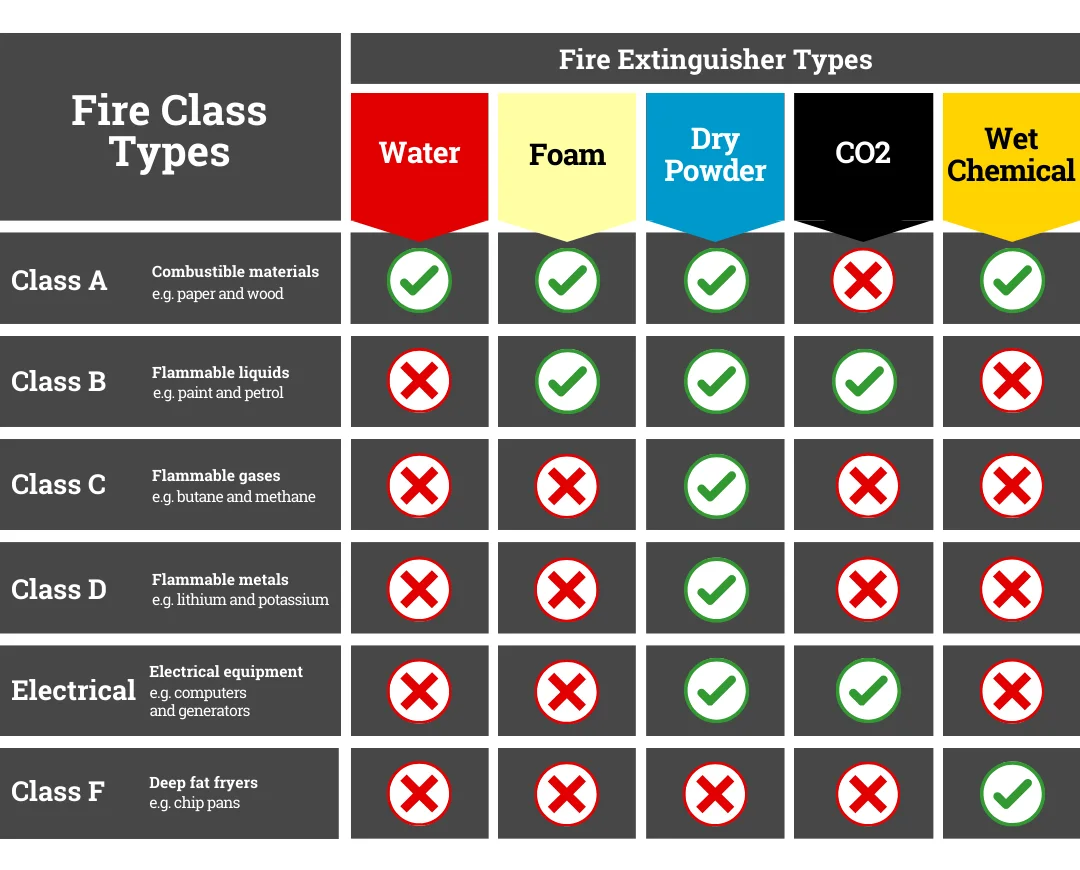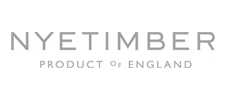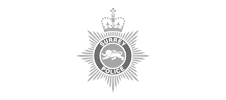Fire Class Guide: Understanding UK Fire Classifications from A to F
Understanding the different classes of fires is crucial for effectively fighting fires and ensuring safety. Fires are classified based on the materials that are burning, and each class requires a specific approach and type of fire extinguisher for safe and efficient extinguishment. Our guide provides a comprehensive overview of the six classes of fires, the best extinguishers for each class, their typical locations, primary use, and suitabilities.
The six fire classes
- Class A fires: combustible materials
- Class B fires: flammable liquids
- Class C fires: flammable gases
- Class D fires: combustible metals
- Electrical: electrical equipment
- Class F fires: cooking oils
Extinguisher usage and the six fire classes

The legal position on fire safety for UK businesses
The Regulatory Reform (Fire Safety) Order 2005 (FSO) states the Responsible Person (RP) has a general duty to take general fire precautions (Article 8) and as defined under Article 4(1)(d) ‘measures in relation to the means for fighting fresh on the premises.’
Article 13 defines this responsibility further:
(1) The responsible person must ensure that:
a) The premises are, to the extent that it is appropriate, equipped with appropriate firefighting equipment
and
b) Any non-automatic firefighting equipment so provided is easily accessible, simple to use, and indicated by signs.
(2) For the purposes of Paragraph (1), appropriateness is to be determined having regard to the dimensions and use of the premises, the equipment contained on the premises, the physical and chemical properties of the substances likely to be present, and the maximum number of persons who may be present at any one time.’
Legally, employers need to ensure that a business premises is correctly fitted with fire extinguishers suitable for tackling the likely fires that will occur on their premises.
Class A fires – ordinary combustible materials

What is a class A fire? These fires are the most common type and can occur in virtually any environment. They are characterised by their ability to be extinguished with water or other extinguishing agents that can cool the burning material.
Type of fire: Class A fires involve ordinary combustible materials such as wood, paper, cloth, rubber, and certain plastics.
Suitable extinguishers: Water, Water Mist, (Foam, Dry Powder and Wet Chemical can also be used).
Extinguisher use
To extinguish fires involving solid materials
Extinguisher suitabilities
Suitable for general use in a wide range of environments
Typical locations
Homes, offices, schools, and other commercial buildings
Class B fires – flammable liquids

What is a class B fire? These fires are fast-spreading, very dangerous, and difficult to extinguish as they can quickly reignite.
Type of fire: Class B fires involve flammable or combustible liquids, such as petrol, kerosene, oil, tar, paint, wax, and solvents.
Suitable extinguishers: Foam, Dry Powder, and Carbon Dioxide CO2.
Extinguisher use
To extinguish fires where smothering the fire to block the oxygen is crucial
Extinguisher suitabilities
Suitable for use in workshops, garages, and industrial settings
Typical locations
Garages, fuel storage areas, painting areas, and industries involving flammable liquids
Class C fires – flammable gases

What is a class C fire: These fires can lead to explosions if not handled correctly and require the gas source to be turned off before extinguishing.
Type of fire: Class C fires involve flammable gases such as propane, butane, methane, and natural gas.
Suitable extinguisher: Dry Powder.
Extinguisher use
To extinguish fires involving flammable gases safely
Extinguisher suitabilities
Suitable for industrial environments and places where flammable gases are used or stored
Typical locations
Kitchens, heating rooms, factories, and any locations where flammable gases are stored or used
Class D fires – flammable metals

What is a class D fire? These fires are extremely hot and require a special extinguishing agent that does not react with the burning metal.
Type of fire: Class D fires involve combustible metals, such as magnesium, titanium, aluminum, and potassium.
Suitable extinguishers: Special Dry Powder extinguishers designed specifically for combustible metals.
Extinguisher use
Suitable for specialised industrial environments
Extinguisher suitabilities
Suitable for general use in a wide range of environments
Typical locations
Electrical fires – electrical equipment

What is an electrical fire? These fires can be caused by short-circuits, overloaded electrical outlets, or other electrical malfunctions.
Type of fire: While not officially classified in the UK and many other countries, Class E is often used informally to describe fires involving electrical equipment.
Suitable extinguishers: Carbon Dioxide CO2 and Dry Powder extinguishers.
Extinguisher use
To extinguish fires without conducting electricity back to the user
Extinguisher suitabilities
Suitable for any environment with electrical equipment
Typical locations
Offices, server rooms, construction sites, and any location that uses electrical equipment
Class F fires – cooking oils and fats

What is a class F fire? These fires are unique to cooking environments and require a specific extinguishing agent to cool the fire and prevent re-ignition.
Type of fire: Class F fires involve cooking oils and fats, such as vegetable oils, animal fats, and greases.
Suitable extinguisher: Wet Chemical extinguishers are designed to tackle cooking oil and fat fires.
Extinguisher use
To extinguish fires involving cooking oils and fats safely
Extinguisher suitabilities
Typical locations
Kitchens, restaurants, cafeterias, and any place where cooking is performed
Fire extinguisher guide
Keep your people safe with us
Learn about the fire extinguishers variants and how they help extinguish the various fire types.
Talk to IPS Fire and Safety about your fire safety responsibilities. From an initial fire risk assessment to team fire safety training and the supply and fitting of fire extinguishers, we’re here to help you keep your people safe and meet your legal fire safety requirements.
Talk to us about how we can help with your fire safety requirements
Our Fire Safety services
FIRE RISK ASSESSMENTS
FIRE ALARMS
FIRE EXTINGUISHERS
FIRE SAFETY TRAINING
Total client protection since 2004
At IPS, your security is our priority. You need dependable protection 24/7, 365 days a year, and for that reason, our engineers are always available. You can depend on us to ensure you are always protected.
100% INDEPENDENT
We’re fully independent, providing unbiased solutions tailored just for you.
EXPERTISE
CUSTOMER-FIRST
COMPREHENSIVE COVERAGE
We're trusted by some fantastic organisations








Contact us for a free quote
Or call the team on 0333 444 5 999
Our Priority is You
We pride ourselves on the impeccable service we provide our customers. From the first conversation to ongoing support for your fire, security and safety needs, you'll wonder why you left it so long to contact us.

